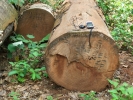 The Agriculture deputy minister for forests, Andr‚ de Jesus Moda, said last Thursday in Luanda that the inventory process to determine the number of forests in the country is being drafted nationwide at this moment.
The Agriculture deputy minister for forests, Andr‚ de Jesus Moda, said last Thursday in Luanda that the inventory process to determine the number of forests in the country is being drafted nationwide at this moment.
The inventory will be a data bank that will enable the divulgence of the country's amount of this resource, so as to start with an exploration in an objective way, thus meeting the national and international demands. According to him, the exploration in Angola has been carried out in a traditional way by the populations and by some companies that operate in areas where the greater quality of humid tropical forests are abundant.
Illegal and unauthorised burnings have been recorded in Angola mainly in the central and northern regions without being weighed the consequences on the ecosystem, he said.
Angola has artificial and natural forests in an area of 53 million hectares.
Angola's rainforests, located in the north of the country, are most threatened by subsistence agriculture which provides food for almost 90 percent of the population. Overgrazing and cutting forest for fuelwood are also significant causes of forest clearing and degradation.
On paper 10 percent of Angola is protected. The country has some 5,185 species of plants, 930 birds, 235 mammals, 296 reptiles, and 85 amphibians.
Overall, Angola has a low deforestation rate relative to its total forest cover. Between 1990 and 2005, the country lost only 3 percent of its forests and the rate of forest conversion has kept fairly steady.
Some areas are reportedly showing the effects of land clearing, including severe soil erosion, heavy siltation of rivers and dams, and desertification.
According to Mongabay, the government is heavily indebted and had sold a number of timber concessions to foreign timber companies. Oil and minerals are also important sources of revenue that could have an adverse impact on the environment.


